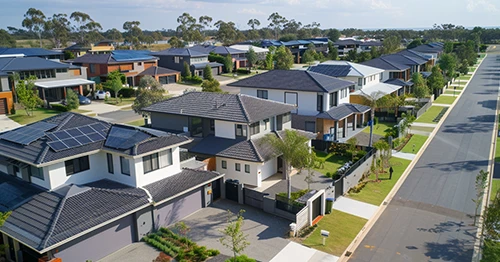Updated: 26 Dec, 2024
CoreLogic’s national Home Value Index (HVI) recorded a third consecutive increase, with a pace of growth of 1.2% in May 2023. After hitting bottom in February, home values increased by 0.6% and 0.5% in March and April, respectively.
Sydney Leading Housing Recovery
Sydney led the recovery trend, with a 1.8% value increase over May. This was Sydney’s highest monthly gain since September 2021. Brisbane and Perth were the other capital cities to experience a rise of more than 1%, increasing 1.4% and 1.3%, respectively.
The premium segment led the recovery trend in Sydney’s housing market. Sydney’s upper quartile had the highest rate of growth, with a 5.6% increase over the past three months, compared with a 2.6% rise in more affordable quartiles.
CoreLogic research director Tim Lawless explained buyers targeting the premium market were still purchasing properties below peak prices. While values in more expensive homes rose faster, dwelling values in Sydney’s upper quartile were still 11.8% lower than the January 2022 peak at the end of May. This translates to a savings of about $213,000 from the cyclical high.
Lawless added that buyers are becoming increasingly competitive due to the limited availability of housing stock, resulting in a sense of FOMO. As competition intensified, auction clearance rates were consistently high, remaining at 70% or above for the past three weeks. In private-treaty sales, homes sold faster and with minimal vendor discounting, indicating a trend towards a seller’s market.
Housing Values in Regional Areas Show Signs of Recovery
Regional housing values experienced an upward trend as well. The combined regionals index rose by 0.5% in May, following 0.2% and 0.1% increases in March and April, respectively. However, the rate of gain in regional home values was slower than in the capitals.
Over the past three months, the combined capitals index grew more than three times faster than the combined regionals index – 2.8% to 0.8%. Lawless explained that while advertised housing supply remained tight in regional Australia, demand from net overseas migration was less significant. Australian Bureau of Statistics (ABS) data revealed that around 15% of the country’s net overseas migration was centred in the regions each year. Moreover, a decline in internal migration rates across the regions helped ease the pressure on the demand side of the housing market.
Housing Market Recovery Uneven Across Major Cities
Most housing markets recorded values well below their recent peaks, despite recent gains.
- Perth was the only capital city where dwelling values returned to record highs.
- Hobart values remained the lowest relative to the city’s cyclical peak in May last year, dropping by 12.6%.
- In Sydney, home values were still 9.6% below the January 2022 peak.
- In Brisbane, values were down 9.4% from the June 2022 peak.
- Melbourne was down 8.2% from a peak in February last year.
Property Market Highlights
Here’s a summary of the major data points from the Australian property market in May 2023.
- The number of homes advertised for sale continued to decline in May. Fresh listings dropped by 13.1% below the previous five-year average across the combined capitals and 18% lower across the combined regional areas.
- Although estimated home sales experienced a slight upward trend, with the number of capital city dwelling sales rising to the highest level since July last year, they were still below the highs recorded in late 2021. Lawless explained the shortfall in available housing supply, relative to demand, was a major factor contributing to the renewed upward pressure on housing values.
- At the national level, an average of 35,143 new listings were added to the market over the past three months, while an average of 39,760 dwelling sales were recorded over the same period. Lawless highlighted that the last time capital city stock levels were this low was in 2007, a period of rapid overseas migration and rising housing values.
- The national rental index increased by 0.8% in May, well above the pre-COVID decade average of a 0.2% month-on-month rise. However, this figure represented a modest slowdown compared with the recent monthly high of 1.0% in March and 0.9% in April.
- The reduction in rental growth was most evident in regional markets, where rents rose 0.3% over the month, while capital city rents increased by 1.0%. Also, the growth in capital city house rents (0.9%) has slowed more visibly than unit rents (1.4%).
- Larger capital city unit markets experienced a rapid rise in rents. Over the past three months, Sydney unit rents increased by 5.7%, Melbourne and Perth unit rents rose 5.2%, and in Brisbane, unit rents increased by 3.8%.
- The market needed more signs of a supply response to the high rental demand. The capital city rental listings were 36.4% below the previous five-year average at the end of May, and vacancy rates remained around the 1% mark for both houses and units.
- There was an early sign of increased investor participation in the market. The number of new investment housing loans secured surged from a recent low of 11,500 in January to around 15,300 in March, although investment loan volumes are still 29.4% lower, year on year.
Uncertainty Looms Over Housing Market Recovery
Several factors affect the outlook for Australia’s housing market:
- A possibility of further rate hikes and the potential for higher levels of mortgage stress and persistently low levels of consumer sentiment.
- Upwards momentum in housing prices may induce a ‘wealth effect’ – a risk factor for inflation when households feel wealthier.
- There is potential for increased mortgage stress as more borrowers refinance fixed-rate home loans that are reaching term.
- While higher interest rates may quell some of the demand-side pressures as borrowing capacity and sentiment decline further, demand from record levels of net overseas migration will remain.
- As selling conditions improve, there may be an increase in the number of homeowners testing the market. Typically, the flow of new listings is low during winter months. We will observe whether more vendors take advantage of improving market conditions and attempt to sell more before the spring rush.
- A rise in available supply would balance the negotiating power between buyers and sellers.





